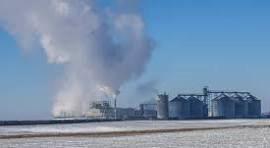A number of companies have applied to Midwest states to establish a network of pipelines to convey carbon dioxide from ethanol plants to disposal sites for deep-ground injection.
All applications for rights of way were strenuously opposed by farmers and were supported by state politicians effectively preventing a geologically acceptable method of disposal. In the absence of securing willing agreements with landowners ordinances and laws were passed to prevent the application of eminent domain since many farmers rejected compensation. The validity of various ordinances passed by counties is in question with a federal judge barring restrictions to have been imposed by Shelby and Story Counties in Illinois.

It is possible that the pipeline system might be revisited after the U.S. Pipeline and Hazardous Materials Safety Administration reviews regulations relating to carbon dioxide that is far more innocuous than petroleum products and natural gas. The Illinois Farm Bureau supports a moratorium until appropriate regulations are promulgated. Carbon dioxide can present a hazard as occurred in Mississippi in 2020 when unusual atmospheric conditions resulted in a plume of released gas threatening a community near a pipeline rupture.
The position of farmers and their political supporters is inexplicable. On the one hand, corn farmers benefit immeasurably from ethanol production. It is unfortunate that for every bushel of corn converted to ethanol, one-third of the volume comprises carbon dioxide. The ethanol industry backed by farmers claims to be environmentally beneficial and “sustainable”. If carbon dioxide produced by ethanol fermentation plants is vented to the atmosphere, the environmental claim based on reduced tailpipe emissions is spurious. The row-crop industry cannot have it both ways. If they wish their corn to be converted to ethanol then there must be a system of collection and disposal of carbon dioxide without release to the atmosphere. Carbon dioxide capture from ethanol plants is feasible but the volume produced exceeds demand. Injection in local areas where plants are located is frequently impractical from a geologic perspective. Farming organizations should take a broader approach to the pipeline system and recognize the need to establish a system of collection, transport and disposal that benefits all of the stakeholders involved.
 |